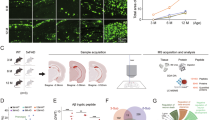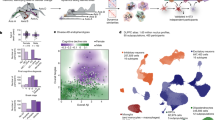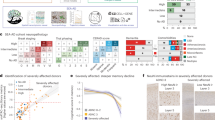Abstract
Aging is a major risk factor for Alzheimer’s disease (AD). With the prevalence of AD increased, a mechanistic linkage between aging and the pathogenesis of AD needs to be further addressed. Here, we report that a small ubiquitin-related modifier (SUMO) modification of p53 is implicated in the process which remarkably increased in AD patient’s brain. Mechanistically, SUMOylation of p53 at K386 residue causes the dissociation of SET/p53 complex, thus releasing SET into the cytoplasm, SET further interacts with cytoplasmic PP2A and inhibits its activity, resulting in tau hyperphosphorylation in neurons. In addition, SUMOylation of p53 promotes the p53 Ser15 phosphorylation that mediates neuronal senescence. Notably, p53 SUMOylation contributes to synaptic damage and cognitive defects in AD model mice. We also demonstrate that the SUMOylation inhibiter, Ginkgolic acid, recovering several senescent phenotypes drove by p53 SUMOylation in primary neurons. These findings suggest a previously undiscovered etiopathogenic relationship between aging and AD that is linked to p53 SUMOylation and the potential of SUMOylated p53-based therapeutics for neurodegeneration such as Alzheimer’s disease.
This is a preview of subscription content, access via your institution
Access options
Subscribe to this journal
Receive 12 print issues and online access
$259.00 per year
only $21.58 per issue
Buy this article
- Purchase on SpringerLink
- Instant access to full article PDF
Prices may be subject to local taxes which are calculated during checkout







Similar content being viewed by others
Data availability
All data needed to evaluate the conclusions in the paper are present in the paper and/or Supplementary Materials. The datasets used and/or analyzed during the current study are available from the corresponding author upon reasonable request.
References
Wyss-Coray T. Ageing, neurodegeneration and brain rejuvenation. Nature. 2016;539:180–6.
Niccoli T, Partridge L. Ageing as a risk factor for disease. Curr Biol. 2012;22:R741–R752.
Turrini S, Wong B, Eldaief M, Press DZ, Sinclair DA, Koch G, et al. The multifactorial nature of healthy brain ageing: brain changes, functional decline and protective factors. Ageing Res Rev. 2023;88:101939.
Elobeid A, Libard S, Leino M, Popova SN, Alafuzoff I. Altered proteins in the aging brain. J Neuropathol Exp Neurol. 2016;75:316–25.
Tiwari S, Atluri V, Kaushik A, Yndart A, Nair M. Alzheimer’s disease: pathogenesis, diagnostics, and therapeutics. Int J Nanomed. 2019;14:5541–54.
Ren W, Li L, Zhang J, Vaas M, Klohs J, Ripoll J, et al. Non-invasive visualization of amyloid-beta deposits in Alzheimer amyloidosis mice using magnetic resonance imaging and fluorescence molecular tomography. Biomed Opt Express. 2022;13:3809–22.
Trejo-Lopez JA, Yachnis AT, Prokop S. Neuropathology of Alzheimer’s disease. Neurotherapeutics. 2022;19:173–85.
Selkoe DJ, Hardy J. The amyloid hypothesis of Alzheimer’s disease at 25 years. EMBO Mol Med. 2016;8:595–608.
Busche MA, Hyman BT. Synergy between amyloid-β and tau in Alzheimer’s disease. Nat Neurosci. 2020;23:1183–93.
Bakota L, Brandt R. Tau biology and tau-directed therapies for Alzheimer’s disease. Drugs. 2016;76:301–13.
Combs B, Mueller RL, Morfini G, Brady ST, Kanaan NM. Tau and axonal transport misregulation in tauopathies. Adv Exp Med Biol. 2019;1184:81–95.
Princz A, Tavernarakis N. SUMOylation in neurodegenerative diseases. Gerontology. 2020;66:122–30.
Anderson DB, Zanella CA, Henley JM, Cimarosti H. Sumoylation: implications for neurodegenerative diseases. Adv Exp Med Biol. 2017;963:261–81.
Flotho A, Melchior F. Sumoylation: a regulatory protein modification in health and disease. Annu Rev Biochem. 2013;82:357–85.
Wilkinson KA, Henley JM. Mechanisms, regulation and consequences of protein SUMOylation. Biochem J. 2010;428:133–45.
Rodriguez MS, Desterro JM, Lain S, Midgley CA, Lane DP, Hay RT. SUMO-1 modification activates the transcriptional response of p53. EMBO J. 1999;18:6455–61.
Gostissa M, Hengstermann A, Fogal V, Sandy P, Schwarz SE, Scheffner M, et al. Activation of p53 by conjugation to the ubiquitin-like protein SUMO-1. EMBO J. 1999;18:6462–71.
Hafner A, Bulyk ML, Jambhekar A, Lahav G. The multiple mechanisms that regulate p53 activity and cell fate. Nat Rev Mol Cell Biol. 2019;20:199–210.
Stine WB Jr, Dahlgren KN, Krafft GA, LaDu MJ. In vitro characterization of conditions for amyloid-beta peptide oligomerization and fibrillogenesis. J Biol Chem. 2003;278:11612–22.
Zhang P, Kishimoto Y, Grammatikakis I, Gottimukkala K, Cutler RG, Zhang S, et al. Senolytic therapy alleviates Aβ-associated oligodendrocyte progenitor cell senescence and cognitive deficits in an Alzheimer’s disease model. Nat Neurosci. 2019;22:719–28.
Chow HM, Shi M, Cheng A, Gao Y, Chen G, Song X, et al. Age-related hyperinsulinemia leads to insulin resistance in neurons and cell-cycle-induced senescence. Nat Neurosci. 2019;22:1806–19.
Lammert CR, Frost EL, Bellinger CE, Bolte AC, McKee CA, Hurt ME, et al. AIM2 inflammasome surveillance of DNA damage shapes neurodevelopment. Nature. 2020;580:647–52.
Lozano-Montes L, Dimanico M, Mazloum R, Li W, Nair J, Kintscher M, et al. Optogenetic stimulation of basal forebrain parvalbumin neurons activates the default mode network and associated behaviors. Cell Rep. 2020;33:108359.
Faraco G, Hochrainer K, Segarra SG, Schaeffer S, Santisteban MM, Menon A, et al. Dietary salt promotes cognitive impairment through tau phosphorylation. Nature. 2019;574:686–90.
Riley T, Sontag E, Chen P, Levine A. Transcriptional control of human p53-regulated genes. Nat Rev Mol Cell Biol. 2008;9:402–12.
Luo HB, Xia YY, Shu XJ, Liu ZC, Feng Y, Liu XH, et al. SUMOylation at K340 inhibits tau degradation through deregulating its phosphorylation and ubiquitination. Proc Natl Acad Sci USA. 2014;111:16586–91.
Farmer KM, Ghag G, Puangmalai N, Montalbano M, Bhatt N, Kayed R. P53 aggregation, interactions with tau, and impaired DNA damage response in Alzheimer’s disease. Acta Neuropathol Commun. 2020;8:132.
Dimri GP, Lee X, Basile G, Acosta M, Scott G, Roskelley C, et al. A biomarker that identifies senescent human cells in culture and in aging skin in vivo. Proc Natl Acad Sci USA. 1995;92:9363–7.
Liu C, Götz J. How it all started: tau and protein phosphatase 2A. J Alzheimers Dis. 2013;37:483–94.
Wang D, Kon N, Lasso G, Jiang L, Leng W, Zhu WG, et al. Acetylation-regulated interaction between p53 and SET reveals a widespread regulatory mode. Nature. 2016;538:118–22.
Chen Y, Tang JH, De Stefano LA, Wenger MJ, Ding L, Craft MA, et al. Electrophysiological resting state brain network and episodic memory in healthy aging adults. Neuroimage. 2022;253:118926.
Schmued LC, Albertson C, Slikker W Jr. Fluoro-Jade: a novel fluorochrome for the sensitive and reliable histochemical localization of neuronal degeneration. Brain Res. 1997;751:37–46.
Schmued LC. Development and application of novel histochemical tracers for localizing brain connectivity and pathology. Brain Res. 2016;1645:31–35.
Nacarelli T, Lau L, Fukumoto T, Zundell J, Fatkhutdinov N, Wu S, et al. NAD+ metabolism governs the proinflammatory senescence-associated secretome. Nat Cell Biol. 2019;21:397–407.
Bao J, Qin M, Mahaman YAR, Zhang B, Huang F, Zeng K, et al. BACE1 SUMOylation increases its stability and escalates the protease activity in Alzheimer’s disease. Proc Natl Acad Sci USA. 2018;115:3954–9.
Yu Z, Cheng C, Liu Y, Liu N, Lo EH, Wang X. Neuroglobin promotes neurogenesis through Wnt signaling pathway. Cell Death Dis. 2018;9:945.
Khan AA, Mao XO, Banwait S, Jin K, Greenberg DA. Neuroglobin attenuates beta-amyloid neurotoxicity in vitro and transgenic Alzheimer phenotype in vivo. Proc Natl Acad Sci USA. 2007;104:19114–9.
Liu B, Liu J, Shi JS. SAMP8 mice as a model of age-related cognition decline with underlying mechanisms in Alzheimer’s disease. J Alzheimers Dis. 2020;75:385–95.
Marcelli S, Ficulle E, Piccolo L, Corbo M, Feligioni M. An overview of the possible therapeutic role of SUMOylation in the treatment of Alzheimer’s disease. Pharmacol Res. 2018;130:420–37.
Singh SK, Srivastav S, Castellani RJ, Plascencia-Villa G, Perry G. Neuroprotective and antioxidant effect of Ginkgo biloba extract against AD and other neurological disorders. Neurotherapeutics. 2019;16:666–74.
Fukuda I, Ito A, Hirai G, Nishimura S, Kawasaki H, Saitoh H, et al. Ginkgolic acid inhibits protein SUMOylation by blocking formation of the E1-SUMO intermediate. Chem Biol. 2009;16:133–40.
Chauhan KM, Chen Y, Chen Y, Liu AT, Sun XX, Dai MS. The SUMO-specific protease SENP1 deSUMOylates p53 and regulates its activity. J Cell Biochem. 2021;122:189–97.
Liu Y, Tavana O, Gu W. p53 modifications: exquisite decorations of the powerful guardian. J Mol Cell Biol. 2019;11:564–77.
Kon N, Wang D, Gu W. Loss of SET reveals both the p53-dependent and the p53-independent functions in vivo. Cell Death Dis. 2019;10:237.
John A, Reddy PH. Synaptic basis of Alzheimer’s disease: focus on synaptic amyloid beta, P-tau and mitochondria. Ageing Res Rev. 2021;65:101208.
Scurr LL, Haferkamp S, Rizos H. The role of sumoylation in senescence. Adv Exp Med Biol. 2017;963:215–26.
Princz A, Tavernarakis N. The role of SUMOylation in ageing and senescent decline. Mech Ageing Dev. 2017;162:85–90.
Chenfei Z, Haizhen Y, Jie X, Na Z, Bo X. Effects of aerobic exercise on hippocampal SUMOylation in APP/PS1 transgenic mice. Neurosci Lett. 2022;767:136303.
Mohamed Asik R, Suganthy N, Aarifa MA, Kumar A, Szigeti K, Mathe D, et al. Alzheimer’s disease: a molecular view of β-amyloid induced morbific events. Biomedicines. 2021;9:1126.
Yun SM, Cho SJ, Song JC, Song SY, Jo SA, Jo C, et al. SUMO1 modulates Aβ generation via BACE1 accumulation. Neurobiol Aging. 2013;34:650–62.
Acknowledgements
This work was supported in parts by grants from the National Natural Science Foundation of China (82330041, 92049107), a grant from Science and Technology Innovation Team project to Xiaochuan Wang from the Department of Science and Technology of Hubei Province (2022-72-18). The authors are grateful to Mr. Dan Ke and Ms. Qun Wang for helpful technical suggestions during the conduct of this study.
Author information
Authors and Affiliations
Contributions
XW conceived the project, designed all experiments, and organized the results. LW and FY planned and performed most of the experiments and organized the results. AY, YL, and YL prepared primary neurons and animal experiments. FL, J-ZW, and RL assisted with data analysis and interpretation and critically read the manuscript. All of the authors were involved in analyzing the data and contributed to manuscript discussion and editing.
Corresponding author
Ethics declarations
Competing interests
The authors declare no competing interests.
Ethics
Animal experiments and manipulation were approved by the Ethics Committee of the Animal Experiment Center, Tongji Medical College, Huazhong University of Science and Technology.
Additional information
Publisher’s note Springer Nature remains neutral with regard to jurisdictional claims in published maps and institutional affiliations.
Supplementary information
Rights and permissions
Springer Nature or its licensor (e.g. a society or other partner) holds exclusive rights to this article under a publishing agreement with the author(s) or other rightsholder(s); author self-archiving of the accepted manuscript version of this article is solely governed by the terms of such publishing agreement and applicable law.
About this article
Cite this article
Wan, L., Yang, F., Yin, A. et al. Age-related p53 SUMOylation accelerates senescence and tau pathology in Alzheimer’s disease. Cell Death Differ 32, 837–854 (2025). https://doi.org/10.1038/s41418-025-01448-0
Received:
Revised:
Accepted:
Published:
Issue date:
DOI: https://doi.org/10.1038/s41418-025-01448-0



